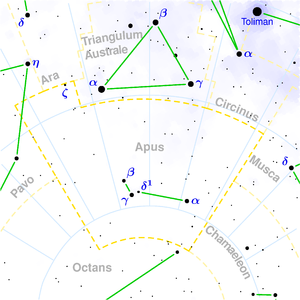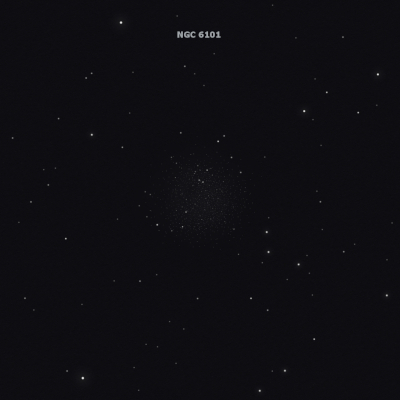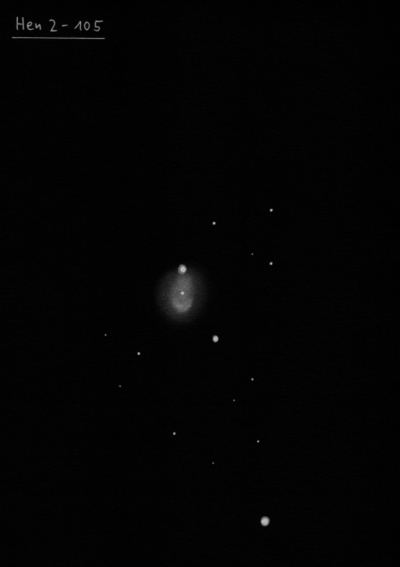Apus is a faint small constellation near the southern celestial pole, lying south of the Circinus, Triangulum Australe, and the Altar. It is not visible in our latitudes or even from the southern shores of Europe. It begins to emerge just above the horizon in equatorial regions. The constellation forms a triangle with its brightest stars: α, β, and γ, among others. The brightest of them is α, a faintly yellowish star with a magnitude of 3.81. Otherwise, the constellation contains practically no interesting objects.

β Aps - A binary star composed of a brighter component with a magnitude of 4.2 and a companion with a magnitude of 12, separated from it by 51". It is likely just an optical binary star, with its main component being of spectral class K0 and located 158 light-years away.
δ Aps - Very wide double star, easily distinguishable even with a regular telescope. The components with magnitudes 4.7 and 5.1 are separated by 103", but they are not physically related at all. These are red giants located at distances of 660 and 760 light years.
θ Aps - Variable, clearly red star, during maximum at the limit of visibility with the naked eye. Its brightness ranges between 6.4mag and 8mag with a period of just over 100 days.
S Aps - This star is a new "reverse". Usually it is brighter than 10mag, so it can be observed even with a small telescope, but it apparently irregularly emits dark material into its surroundings, which reduces its brightness by 100 times to 15mag. After a few weeks, when the veil dissipates into the surroundings, it will shine again in its original brilliance.
NGC 6101

James Dunlop discovered NGC 6101 = D 68 = h3623 on 1 Jun 1826 and recorded "A pretty large rather faint round nebula, about 3.5-4' diameter, a little brighter in the middle. There is a very small nebula on the N.p. side joining the margin of the large nebula." Dunlop's position is off by a relatively small 4'.
On 18 Jun 1835, John Herchel recorded "Globular cluster, large, faint, round, very gradually a little brighter in the middle, all resolved into stars 15..18th mag, 4' diam, with stragglers. A delicate and beautiful object." A week later he called it "pretty bright, large, irregularly round, gradually brighter in the middle, resolved into stars 13..16th mag; pretty compressed, diam 5' or 6' by estimation, approx. 50 seconds in RA. A fine object."
300/350mm - 12" (6/29/02 - Bargo, Australia): at 140x this moderately faint globular is ~4' diameter with just a weak concentration. A scattering of mag 14 stars pepper the face of the cluster and at the edges of the irregular halo.
400/500mm - 18" (7/6/05 - Magellan Observatory, Australia): at 171x; fairly large but apparently loose globular with about two dozen stars resolved and little central concentration. At 228x at least three dozen stars mag 14 and fainter were resolved including a clump of faint stars near the center. At this power the periphery is quite irregular and ragged with most of the brighter resolved stars hugging close to the edges of the halo. A group of brighter mag 11 field stars are just off the NNE side. A mag 10 star lies 8' NW of center and a similar star is placed 7' SE. Located 28' SE of a mag 6.7 star.
18" (7/5/05 - Magellan Observatory, Australia): at 128x appears moderately bright, fairly large, round, 4'-5' diameter. This globular has an unusual appearance, as there was only a weak concentration except for a very small brighter nucleus. At 228x many mag 14-15 stars are superimposed over the background glow while a number of faint stars huddle around the edges of the halo. Several of the faint, resolved stars reside very near the center and these may have been the "very small brighter nucleus" I noticed at only 128x.
Notes by Steve Gottlieb
IC 4499
DeLisle Stewart found IC 4499 = D.S. 418 on a plate taken on 13 Jun 1901 at Harvard's Arequipa Station. He noted "vF Cl, 4' diam., 3 F st inv in cl, position approximate, susp."
400/500mm - 18" (7/7/02 - Magellan Observatory, Australia): at 171x this globular has an unusual appearance as a round glow of nearly even surface brightness, ~3.5' diameter with a single brighter mag 12 star superimposed near the very center. A brighter mag 10.5 field star is just off the south edge, 2' from the center. IC 4499 appears similar to a large, fairly low surface brightness planetary or reflection nebula. This observation was possibly compromised by some clouds as the skies completely clouded up soon afterwards, but there was no evident resolution at this power.
Notes by Steve Gottlieb
